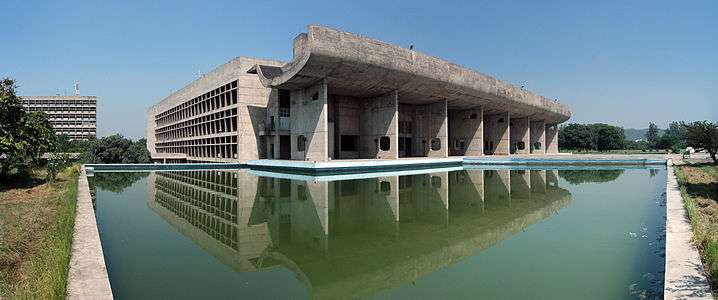Palace of Assembly (Chandigarh)



Palace of Assembly is a legislative assembly designed by noted architect Le Corbusier and located in Chandigarh, India.[1][2] It is part of the The Capitol Complex, which comprises three buildings — Legislative Assembly, Secretariat and High Court.[3] This building was designated as a UNESCO World Heritage Site in 2016.[4][5]
Architectural history
After the partition of Punjab, in 1947 following the independence of India, the divided Punjab required a new capital as Lahore was now in Pakistan. Thus Le Corbusier was commissioned by first prime minister of India, Jawaharlal Nehru to build a new city of Chandigarh as the capital of Punjab and newly carved state of Haryana. The brief for the design was a city "unfettered by the traditions of the past, a symbol of the nation's faith in the future". Subsequently, Corbusier and his team built not just a large assembly and high court building, but all major buildings in the city, and down to the door handles in public offices. Today many of the buildings are considered modernist masterpieces, though most are in a state of neglect. In 2010, chairs from the assembly building were auctioned in London; a diplomatic attempt to stop the sale failed, as the items were "condemned" and deemed unfit for use. .[1]
References
| Wikimedia Commons has media related to Palace of Assembly (Chandigarh). |
- 1 2 Burke, Jason (7 March 2011). "Le Corbusier's Indian masterpiece Chandigarh is stripped for parts | Art and design". The Guardian. Retrieved 2013-07-02.
- ↑ "Conserving Le Corbusier's heritage comes into focus". The Times Of India. 23 March 2004. Retrieved 2014-09-16.
- ↑ Sandhu, Khushboo (19 June 2010). "Capitol Complex, as Le Corbusier wanted it, remains incomplete". Indian Express. Retrieved 2013-07-02.
- ↑ Tile: UNESCO approves all 3 Indian nominations for heritage tag, Publlisher: India Today news, Pblished on: 18 uly 2016, Accessed on: 18 July 2016
- ↑ "Four sites inscribed on UNESCO's World Heritage List". whc.unesco.org. UNESCO World Heritage Centre. 15 July 2016. Retrieved 15 July 2016.
Coordinates: 30°45′26″N 76°48′24″E / 30.7573°N 76.8066°E